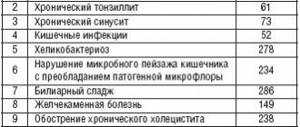Analysis for salmonellosis. Salmonellosis is a dangerous food infection that can be contracted when a pathogenic bacterium, salmonella, enters the body.
The causative agent of the disease is a bacteria in the form of a stick with a curved end - Salmonella. The manifestation of the disease involves a rapid incubation period - from several hours to 5 days, after which the disease can be suspected based on characteristic symptoms. Ease of recognition also lies in the fact that these symptoms are not typical for other intestinal infectious diseases of the child.
Infection, as a rule, occurs through consumption of animal products: meat, eggs, milk, as well as through contact with infected people. Outbreaks of salmonellosis are most often widespread, with the peak incidence occurring in the summer.
What is known about the causative agents of salmonellosis?
In 1880, Salmonella was first isolated from a patient with typhoid fever. Further study revealed almost similar bacteria in pigs, chickens, and other animals. It turned out that the causative agents of salmonellosis are most often found in patients with a clinical picture of acute poisoning or gastroenteritis.
Data from modern microbiological studies make it possible to divide the class of Salmonella into two species and identify 7 subtypes. Previously, it was believed that there were much more of them, but immunological studies of pathogens have proven numerous varieties associated with the antigenic composition (up to 2500).
The diagnosis of salmonellosis is made after identifying a specific cause in the patient. For humans, the main infecting species is the subspecies Enterica. It was detected in 99% of patients. Salmonella subtype Typhimurium - can cause severe widespread (generalized) damage with the presence of the pathogen in the blood.
Rarely found options include:
- Choleraesuis,
- Heidelberg,
- Derby
- Anatum.
Scatological examination changes in the structure of stool
With salmonellosis, certain changes in stool are present. This indicates that bacteria have begun to affect the functions and condition of the intestines, namely:
- excretion of blood, leukocytes, erythrocytes in feces,
- the amount of starch in the body increases,
- the number of muscle fibers that are not digested in the gastrointestinal tract infected with salmonella increases.
Serological testing is carried out over 5-7 days, and diagnosis using PCR will take a day. How long it will take before the answer comes depends only on what kind of analysis was ordered. Only a doctor will make the correct diagnosis and prescribe the necessary treatment based on complaints, examination and diagnostic results.
Characteristics of the pathogen
Salmonella are rod-shaped and Gram-negative in color. They move well. Capable of forming a protective capsule of polysaccharides. They belong to facultative (conditional) anaerobes, that is, they are able to live both in an oxygen environment and without it. Energy is obtained as a result of redox reactions of compounds extracted from the host’s body.
Salmonella are equipped with many pili (villi on the surface) and flagella
Biochemical properties form the basis for creating nutrient media. Salmonella are capable of breaking down many carbohydrates (except lactose, sucrose), including glucose, maltose, arabinose, and forming acid and gas.
Individual types have distinctive properties, which are also used in microbiological diagnostics. For example, Typhi does not produce gas, and Paratyphi A does not produce indole. All salmonella break down protein into hydrogen sulfide. They do not have the oxidase enzyme, but contain catalase.
Salmonella is distinguished by its survivability and remaining infectious:
- in rivers and open reservoirs - 120 days;
- salty sea water - a month;
- land up to 9 months;
- household dust - up to 1.5 years;
- sausage and meat products - from 2 to 4 months;
- when freezing meat - 12 months;
- eggs - 1 year;
- in the shell - almost a month.
Salmonella use products such as milk, cottage cheese, sour cream, and minced meat as a nutrient medium where they actively multiply.
Bacteria are especially sensitive to heat, boiling, and the action of chlorine-containing disinfectants.
Examination methodology
How much analysis is done depends on the workload of the laboratory. The maximum execution time is two weeks. The duration of the study is due to the complex mechanism of stool culture.
Assessment of the state of intestinal microflora includes:
- Stool bacterioscopy (examination using a microscope) for the presence of pathogenic microorganisms.
- Bacteriological culture. The excrement samples are distributed into several laboratory containers, pre-filled with nutrient media for bacterial growth. If pathogens are present in feces, in a favorable environment they begin to actively multiply, forming colonies. The number of CFU determines the severity of the infection.
- Determination of resistance (resistance) of identified bacteria to various types of antibiotics.
The last point of the study allows the doctor to select the most effective drug and prescribe the correct treatment regimen.
What properties determine the ability of salmonella to infect humans?
The degree of infectivity is determined by the virulence factors of Salmonella. These include:
- synthesis of special proteins that facilitate the penetration of the pathogen into intestinal epithelial cells and ensure survival;
- stimulation of cytokines and chemokines by Salmonella to an inflammatory response;
- destruction of human blood macrophages;
- reproduction inside macrophages with the release of endotoxins;
- the effect of endotoxins promotes damage to blood vessels and nerve endings of the intestine, increases cell permeability;
- stimulation of chloride secretion and severe diarrhea.
What antigenic properties of Salmonella are used for diagnostic purposes?
Immune diagnostics of salmonellosis has rich possibilities due to the presence of pronounced antigenic properties in the pathogen. They can be used to type the type of salmonella. There are 3 main antigens:
- O-antigen - can withstand prolonged boiling (2.5 hours), has endotoxin properties;
- H-antigen - located in flagella, destroyed when heated above 75 degrees, consists of flagellin protein. A significant distinguishing feature from other enterobacteria is the ability to secrete both antigens in phases.
- K-antigen - contained in the capsule.
The Vi antigen is characteristic only of typhoid and paratyphoid pathogens. Based on the predominant antigenic structure, F. Kaufman and P. White in 2001 proposed a classification of Salmonella, which is still used today.
To conduct immune tests for salmonellosis, a blood or urine test is taken from the patient or contact person.
Serological testing is considered quite labor-intensive, so it is rarely used in the form of a hemagglutination reaction using erythrocyte diagnostics. Not only the presence of antibodies is determined, but also their titer. 1–2 ml of blood is enough for analysis. It is diluted with an isotonic solution and a diagnosticum with O-antigen is added.
The result is important when determining antibodies at a dilution of 1/100 and an increase in titer in dynamic studies by almost 4 times. The indirect hemagglutination reaction is considered more sensitive.
Possible negative results:
- in cases of mild forms of the disease;
- on the contrary, with severe salmonellosis, in newborns and infants.
If an analysis for salmonellosis is taken from feces or urine, then coagglutination reactions and the enzyme immunoassay method are used.
Treatment
To treat the disease, hospitalization is carried out only in cases of severe or complicated disease. In addition, epidemiological indications may serve as a reason for hospitalization. In cases of severe intoxication and dehydration, bed rest is indicated.
If the patient's condition, in accordance with his clinical characteristics, allows treatment using gastric lavage tactics, the use of siphon enemas and various enterosorbents, they are used accordingly.
Also, treatment is focused on eliminating the condition accompanying dehydration (dehydration), which, first of all, requires the internal use of solutions of glucose-salt composition (Regidron, Citroglucosolan, Oralit, etc.), which requires preliminary consideration of salt and water deficiency before starting therapy, replenishment is carried out by frequent and fractional drinking (up to 1.5 l/h) for two to three hours. Subsequent fluid loss is also taken into account (after these therapeutic measures have been implemented). It is advisable to use these solutions for I-II degrees of dehydration, but if we are talking about III and IV degrees, then polyionic isotonic crystalloid solutions are already used here, they are administered intravenously, in a stream, until the onset of a state in which signs indicating dehydration disappear shock, after which the solutions are administered by the drip method.
Intoxication with its accompanying symptoms is eliminated, in the case of the gastrointestinal form of the disease, by using, for example, indomethacin. The relevance of its use is determined by the early stages of the disease; administration consists of a three-time dosage of 50 mg within 12 hours. Antibiotics, like other types of etiotropic drugs, are not prescribed in the case of the gastrointestinal form. The need for their use is dictated solely by the generalized form of the disease in a form and form determined on an individual basis. Also in this case, a reasonable option is to prescribe complex enzyme preparations. Additionally, diet No. 4 is prescribed for diarrhea, and after diarrhea disappears, diet No. 13 is prescribed.
To diagnose a disease in the presence of relevant symptoms, consultation with an infectious disease specialist is necessary.
https://youtube.com/watch?v=8qyQrGcOZqc
Cultural properties of salmonella and their significance in the tank. diagnostics
Laboratory diagnosis of salmonellosis is based on the bacteriological method of examining stool. It is much more accessible and quite informative. It is carried out in epidemiological laboratories on the direction of a doctor.
The abilities of the pathogen are taken into account:
- grow on the simplest nutrient media at a temperature of 8–45 degrees;
- form uniform turbidity in a liquid medium;
- give translucent colorless colonies on meat peptone agar.
There are selective environments. This is the name given to the addition of specific substances in which only salmonella colonies survive. These include any media with bile, selenite broth, bismuth sulfite agar. Differential diagnostic media are considered lactose-containing options: Endo, Levina, McConkey. Colonies grow colorless because salmonella are unable to break down lactose.
For loop inoculation, a sample of material is taken and spread on a Petri dish containing a nutrient medium
Salmonella can be detected in feces, vomit, urine, gastric lavage, blood and cerebrospinal fluid. Blood culture is considered optimal during the period of fever. It is enough to take about 7 ml of blood from the cubital vein and inoculate it in bile broth or Rapoport medium.
Tank analysis includes a mandatory study of the biochemical properties of the pathogen and study of the structure under a microscope. When determining the duration of the study, it is necessary to take into account not only the work of laboratory technicians, but also how long it takes for colonies to grow.
Usually the result is given after a week. Positive data are obtained during bacterial testing in 40–80% of patients with symptoms of salmonellosis. The maximum seeding rate occurs in the first 7 days of the disease.
During an epidemiological investigation of a salmonellosis outbreak, as directed by a doctor, the following are taken for analysis:
- leftover cooked dishes;
- products used in culinary processing;
- washes from kitchen equipment, plates;
- when infection is detected in a medical institution, wash off the hands of personnel and equipment.
Each case takes into account compliance with food preparation technology, sanitary treatment and the condition of the facility.
Characteristic black shiny colonies form on bismuth sulfite agar
Preparation and collection of biomaterial
To obtain reliable results, the patient should adhere to the conditions of preliminary preparation and the rules for collecting excrement for examination. One of the most important conditions of the preparatory stage is the prohibition on independent (without medical recommendations) use of:
- antibacterial therapy drugs;
- laxatives and fixatives;
- tablets that enhance peristalsis;
- sorbents (Polysorb, Activated carbon, Enterosgel, etc.).
The listed medications can destroy part of the intestinal microbiota. This will negatively affect the accuracy of the analysis results.
The patient's responsibilities during the preparatory period include the following. 2-3 days before donating the biomaterial, eliminate from the diet heavy fatty foods (meat, mushrooms, fatty sauces), foods that provoke flatulence (cabbage, milk, brown bread, legume dishes), carbonated drinks, sweet baked goods.
For three days, eliminate the use of alcohol, stop using rectal suppositories, use microenemas, purchase a sterile sealed container with a spoon from the pharmacy for submitting excrement for analysis (for loose stools, you need to buy a pipette). If the patient is prescribed an X-ray of the digestive organs with contrast, the diagnosis should be made after submitting the excrement for analysis.
The radiation exposure and contrast agent administered to the body will affect the intestinal microenvironment, which may distort the final data. New foods (complementary foods) should not be introduced into the menu for infants. This can cause allergies or dyspeptic syndrome (digestive problems).
The study of stool for disgroup involves two options for collecting material: independently at home in a pharmacy container, taking a rectal smear (or liquid substance) in a medical institution. The conditions for preparing the body are identical in both cases.
Morning stool samples are suitable for microbiological research. Before collecting biomaterial, you should perform hygiene of the anorectal area (without perfumed cleansers) and empty your bladder. Women are not recommended to collect stool during the first seven days of the follicular phase of the menstrual cycle. If an urgent examination is necessary, care must be taken to ensure that menstrual fluid does not get into the material being examined.
It is incorrect to collect feces directly from the toilet. It is necessary to use a vessel or ensure the sterility of excrement using plastic film or stationery paper. In infants, fresh feces can be collected from a diaper. In this case, care should be taken to ensure that no fibers of hygienic material get into the container.
Using the plastic spoon provided with the container, you need to move the feces fragments into the container. If there are pathological purulent, flaky or mucous impurities in the excrement, their particles must be sent for analysis. Fill the third part of the container and close the lid tightly.
The greatest information content of the data is ensured by the immediate delivery of excrement to the research site (to the laboratory). Samples should not be frozen or left at room temperature. Facultative anaerobes do not tolerate changes in temperature and may die. In this case, the study will lose its meaning.
A smear is taken in a medical facility using a swab. A sterile cotton swab is inserted into the rectum, rolled several times and removed. After this, the sample is placed in a laboratory container with liquid nutrient contents.
A sample of loose stool is collected through a catheter. This method is intended for collecting liquid feces. One end of the medical instrument is inserted rectally into the patient, the other is placed in a laboratory vessel. The procedure for collecting a rectal smear may cause minor temporary discomfort in the anorectal area.
How are infection routes identified in a laboratory?
To determine who and how to get tested for salmonellosis, possible sources of the pathogen are taken into account. A sick person with a mild form or a carrier is identified by examining all personnel and a circle of contact persons by taking a stool smear for a disgroup.
The study included the most common infectious diseases that manifest the same clinical picture (diarrhea, fever, abdominal pain, vomiting):
- dysentery,
- salmonellosis,
- amoebiasis,
- rotavirus infection.
The material is collected from the anus only under the supervision of a medical professional in the infectious diseases room using a sterile thin cotton swab. If salmonella or other infectious agents are detected, the employee is suspended from work for the period of treatment and obtaining control negative results.
Poultry (chickens, ducks, turkeys) are the source of human infection in half of the cases. Salmonella is found inside the intestines or in the blood of birds and penetrates the shell of eggs of laying birds. Infection occurs when eating unboiled eggs. Insufficient cooking temperature.
Some mothers practice preparing a drink for their children from beaten raw eggs with sugar and milk, forgetting about salmonellosis
Domestic animals (cats, dogs, hamsters, mice), as well as livestock (pigs, cows) can be carriers of the infection. They transmit salmonella through the external environment contaminated with feces, saliva, and urine. Children get the pathogen with dirty hands. Up to 20% of cases of infection depend on the consumption of pork and beef.
Fish, shellfish, crayfish, and crabs are considered very rare sources.
Meat can become infected by a sick person during transportation, storage, and processing.
Outcome indicators
When salmonellosis develops and certain diagnostics are carried out, doctors decipher the data obtained and draw conclusions about the patient’s health status and the course of the disease. Below are signs of pathology identified through the study of biological material.
| Survey | Changes |
| UAC | Increased white blood cell count |
| Increased erythrocyte sedimentation rate | |
| Leukocyte formula shift to the left | |
| TANK | Violation of water-electrolyte balance (dehydration) |
| Increase in urea and creatinine concentrations | |
| Serological diagnosis | Determination of several antigens: O, H, K, Vi |
| PCR | Detection of pathogen DNA during the study of biomaterial |
| Coprogram | High concentration of fatty acids |
| Amilorrhea | |
| Creatorea | |
| The presence of mucus, with advanced salmonellosis - pus | |
| Bacterial culture | Isolation of a pure culture, the color of which depends on the nutrient medium |
The doctor should decipher the results, since only he can compare the clinical picture with the examination conclusions.
Epidemiological diagnosis
Diagnosis of salmonellosis takes into account:
- clinical course and features of symptoms;
- clarification of the focus of prevalence;
- examination of contact persons;
- identification of violations of sanitary standards;
- food research.
Group cases of the disease in the genus pose a particular danger. homes, psychiatric hospitals, nursing homes and homes for the disabled. Salmonellosis can lead to termination of pregnancy in an expectant mother and death of infants.
The sanitary service has been granted broad rights to conduct an investigation to identify the sources of infection and quickly contain the spread
Decisions are made to temporarily close retail outlets, hospitals or repurpose them into infectious diseases departments, and treat premises with disinfectant liquids. The perpetrators are punished with administrative measures and fines. Preventing the spread of infection in the territory depends on how quickly epidemiologists do their work.
Analysis for salmonellosis
In the rating scheme of recommendations for accepting a diagnosis, testing for salmonellosis is in first place. For reference: the opinion of experts is in the last – fourth. Bacteriological analysis (stool, blood) is in use. It grows the crop and evaluates its resistance to antibiotics. Salmonella food poisoning is not considered dangerous. Medicines of this kind are used for a generalized form - when there is a risk of complications.
The doctor will tell you about the test - in the laboratories the nuances are emphasized. Some take a stool test for salmonellosis, others take a blood test. The dependence on the stage of the disease is recorded. First, a blood culture is detected, then antibodies appear. Based on changes in titer in two samples, doctors make a diagnosis. Tank. culture for salmonellosis is not the only scheme. Molecular genetic methods (DNA research) are used.
Clinical diagnosis of salmonellosis
Clinical diagnosis of salmonellosis is based on taking into account specific symptoms and distinctive signs with other similar diseases.
Typical signs of salmonellosis include manifestations of acute damage to the stomach and intestines:
- the onset is sudden, the severity increases quickly;
- fever, chills;
- vomiting of eaten food and bile in the first hours of the disease;
- headache;
- maximum pain in the epigastrium in the gastritic form, along the intestine in the gastroenteric course, in the right iliac region in the case of gastroenterocolitis;
- the tongue is dry, covered with a thick coating;
- accumulation of gas and rumbling in the intestines;
- diarrhea with greenish feces and a foul odor, mixed with mucus and blood.
Children under one year old are characterized by dehydration, enlarged liver and spleen, drowsiness, lethargy due to the toxic effect on the brain, and possible convulsions.
A vivid clinical picture begins with the usual feeling of weakness
In the blood test, significant leukocytosis is observed with a shift of the formula to the left, and an increase in ESR. In most cases, at this stage the infectious process can be completed.
A severe course (typhoid-like) is observed when the causative agent of salmonellosis enters the bloodstream and is accompanied by a septic condition, severe intoxication, and a roseola rash. Salmonella can cause dystrophy in the spleen and liver and form foci of secondary purulent inflammation throughout the body.
Features of the course of the disease
After salmonella overcome factors related to nonspecific protection in the environment of the oral cavity, as well as in the environment of the stomach, they find themselves in the lumen of the small intestine - here they attach to enterocytes with the subsequent release of heat-stable and/or heat-labile exotoxins. In the process of interaction between bacteria and epithelial cells, degenerative changes in microvilli begin to occur. The process of intervention of the salmonellosis pathogen to the submucosal layer in the intestinal wall begins to be hampered by phagocytes, and this, in turn, leads to the development of an active inflammatory reaction.
The destruction of bacteria is accompanied by the release of endotoxin, which, in turn, plays a major role in the development of intoxication syndrome. Subsequently, against the background of the specific effects of infection and the processes relevant for this, diarrhea and dehydration of the body develop, and dehydration is particularly facilitated by the effect of bacterial enterotoxins, based on the activation of the adenylate cyclase system and the production of cyclic nucleotides.
Due to current dehydration with intoxication, the activity of the cardiovascular system is affected, this manifests itself in a decrease in blood pressure and the manifestation of tachycardia. Also, the clinical condition is accompanied by an acute form of brain swelling and edema. Due to disturbances associated with microcirculation, as well as dehydration, dystrophic processes develop on the part of the kidney tubules. This, in turn, leads to the development of acute renal failure, the first clinical manifestation of which is oliguria - a condition in which the daily volume of urine output decreases from 1500 ml to 500, which occurs either as a result of reduced filtration or as a result of increased absorption , occurring in the kidneys. Subsequently, in addition to oliguria, nitrogenous waste accumulates in the blood.
As a rule, in approximately 95-99% of the total number of cases, Salmonella does not spread beyond the submucosal layer in the intestine, which, however, causes the development of the disease in the gastrointestinal form. Pathogens enter the blood only in some cases, which, in turn, determines the generalized form of the disease, characterized by a septic or typhus-like course. The deficiency relevant for humoral and cellular immune reactions determines the transition to such a generalized form.
Conducting a microscopic examination of the area of the intestinal wall determines changes occurring in the vessels in the form of hemorrhages occurring in the submucosal and mucous layers of the intestinal wall. The submucosal layer, in addition to microcirculation disorders, is also characterized by the development of a leukocyte reaction and subsequent edema.











